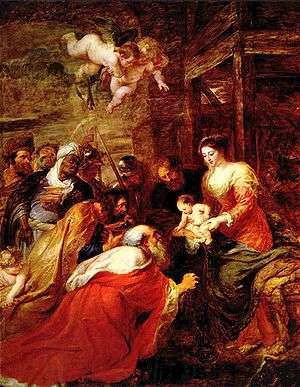Adoration of the Magi (Rubens, Cambridge)
 | |
| Artist | Peter Paul Rubens |
|---|---|
| Year | ca. 1616–17 |
| Medium | Oil on canvas |
| Dimensions | 251 cm × 338 cm (99 in × 133 in) |
| Location | King's College Chapel, Cambridge, Cambridge |
- For other treatments of this subject by the same artist, see Adoration of the Magi (Rubens).
The Adoration of the Magi is a c.1616-17 painting by the Flemish Baroque artist Peter Paul Rubens, now in King's College Chapel, Cambridge. There is an oil preparatory sketch, long hidden in private collections.[1]
History
The painting was purchased by Maximilian II Emanuel, Prince-Elector of Bavaria in Antwerp in September 1698, from Gijsbert van Ceulen, part of a spectacular group of paintings that included twelve other paintings by Rubens that are now among the Wittelsbach works of art from Schleissheim[2] now in the Alte Pinakothek, Munich. It languished as a copy until Jacques Fouquart resuscitated its reputation, recognized as a major work of Rubens, in the exhibition Le siècle de Rubens, Paris, 1977-78.[3]
It was bought for a world-record price in 1959 by the property millionaire Alfred Ernest Allnatt and two years later he offered it to King's College Cambridge. The college accepted "this munificent gift" with the intention of displaying the painting in the college chapel, possibly as an altarpiece. The painting was initially displayed in the college's antechapel, but the decision was taken to modify the east end of the main chapel and in 1968 it was installed there, where it now is.[4]
See also
- Adoration of the Magi (Filippino Lippi)
- Adoration of the Magi (Gentile da Fabriano)
- Adoration of the Magi of 1475 (Botticelli)
- Adoration of the Magi (Andrea della Robbia)
- Adoration of the Magi (Leonardo)
- Adoration of the Magi (Mantegna)
- Adoration of the Magi (Velázquez)
Notes
- ↑ Peter C. Sutton, in Peter C. Sutton, Marjorie E. Wieseman, Nico van Hout Drawn by the brush: oil sketches by Peter Paul Rubens (exhibition catalogue) 2004: no. 6, pp 108f.
- ↑ H. Bever, Katalog der Gemälde-Galerie im K. Schlosse zu Schleissheim (Munich, 1905).
- ↑ No. 128 in the exhibition catalogue.
- ↑ http://www.kings.cam.ac.uk/archive-centre/college-archives/tour/religion/installation.html
